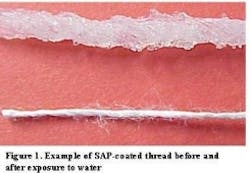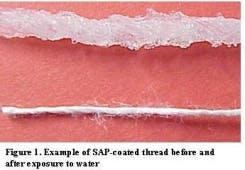Salt and sea water blocking for ‘totally dry’ terrestrial optical cables
- Elimination of the need to purchase solvents and wipes to remove gel and oil
- Tools, cabinets, and closures stay cleaner without exposure to gels and oils
- Dry cables are in general lighter in weight than gel-filled cables. This has the added advantages of making the cables easier to handle and adds less load onto aerial infrastructure.
Too much salt
Despite these advantages, the problems SAP encounters with salt water has limited the use of dry cables. An informal poll in Q2 2011 of three major U.S. fiber-optic cable companies revealed that perhaps 40% of the U.S. optical cable market comprises dry cable, while about 60% of customers still purchase gel-filled cables.
SAP’s salt problems don’t end with absolute water absorption. The speed with which the SAP absorbs water is greatly reduced as well. This latter point is also very important in that if SAP reacts too slowly, water may penetrate far inside a cable before absorption occurs. SAP technologies have an inherent “delay” in absorbing once initial contact with water is made. So, it is important to specify not only how much water a dry technology can absorb, but perhaps more importantly how quickly the technology reacts to block water.
| Average Absorption Speed in De-ionized Water | Average Absorption Speed in Sea Water | Average Absolute Absorption in De-ionized Water | Average Absolute Absorption in Seawater | |
| Supplier A | 6 | 2 | 50 | 20 |
| Supplier B | 15 | 2 | 75 | 40 |
| Supplier C | 30 | 5 | 100 | 60 |
The table above represents an average of many samples from the same size (denier) water-blocking aramid threads from three leading vendors of water-blocked thread commercially sold in the U.S. for use in dry-blocking fiber-optic cables. Seawater was generated by use of commercially available seawater kits such as those sold for salt water fish aquariums. By definition these kits incorporate salt (and other ingredients to lesser extent) with approximately 3.4% incorporation into water. Target salinity is 27 to 35 parts per thousand.
While space does not allow a complete description of the test procedures (you can contact the author for these), here is an overview:
- To measure absorption speed a 1-m length of thread is weighed dry. Then, the thread is placed in a water solution for 1 minute. The thread is removed and again weighed. Subtracting the beginning and ending weights yields the amount of water absorbed, equating to gram per gram per minute (gr/gr/min) absorption speed.
- A similar method is used to calculate absolute absorption, simply with a long time period (long enough for the threads to reach a point at which they no longer absorb).
Parameters for successful sea/salt water performance
It can be seen from the test data in the table that even the best (fastest absorbing) product on the market exhibits greatly reduced absorption speed in seawater versus de-ionized water. This particular product exhibited borderline water penetration performance when tested in actual optical cable (GR20 FOTP-82 one meter water penetration test). That is especially interesting considering Supplier C’s absolute absorption in seawater is higher than Supplier A’s absorption in de-ionized water, again highlighting the importance of absorption speed as a measure of blocking seawater.
Supplier A on the other hand successfully sells this product on the U.S. and global markets for dry blocking deionized water in fiber-optic cable. So an average of 6 gr/gr/min absorption speed is assumed as a minimum level that would be required for producing a quality seawater blocking product.
With this in mind a suggested target value for average absorption speed in seawater might be something above 6 gr/gr/min. Owing to the borderline seawater blocking performance in cable at 5 gr/gr/min absorption speed, one might consider a value of 7 to 8 gr/gr/min to give some margin.
While absolute absorption is less obvious to specify a minimum acceptable performance level, certainly something above 50 to 60 gr/gr is needed based on current industry minimum performance levels. A figure such as 70 to 80 gr/gr might be considered as a minimum acceptable average absorption.
Summary
Knowing what performance levels (absorption and absorption speed) are currently considered successful when blocking de-ionized water gives an indication of what the targets should be for blocking sea/salt water in dry optical cables. With these values understood a cable can then be produced to successfully block sea/salt water and then deployed anywhere a gel-filled cable is currently used.
Ryan Chappell manages global sales, fiber optic products at Coats North America, a division of Coats plc. He can be reached at [email protected].
References:
1. National Fiber Optics Engineers Conference 2003, Peter A. Weimann, Richard H. Norris, Howard M. Kemp, Richard G. Gravely, Swati Neogi, “A New Family of Totally Dry Outside Plant Cables,” pp. 3 (2003).
2. FTTH Council, www.ftthcouncil.org, “Fiber 101 - Deployment Cost Models."

